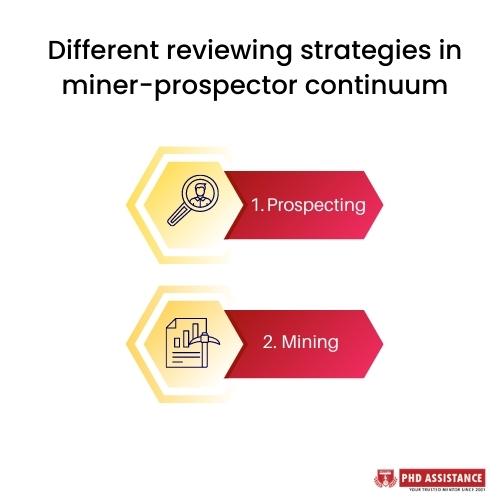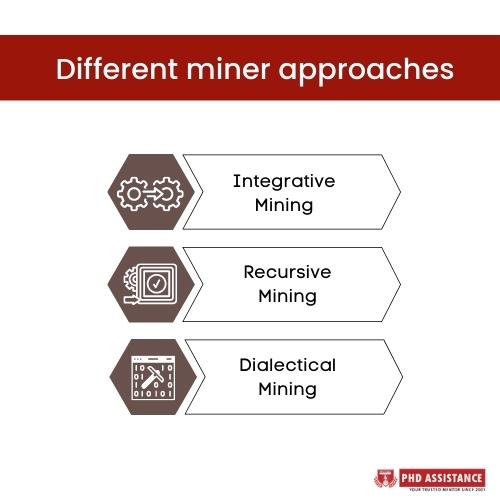Different Reviewing Strategies and Miner approaches Adopted in Theorizing through Literature Review Paper?
In brief
Literature reviews play an increasingly important role in theory development, and understanding how they contribute to the process of theorizing is lacking. This Blog develops the metaphor of a miner-prospector continuum (Breslin, D 2023), which allows review scholars to identify approaches taken in literature reviews to develop theory. Identified the strategies on a continuum ranging from miners—who position their contributions within a bounded and established domain of study alongside other researchers—to prospectors, who are more likely to step outside disciplinary boundaries, introducing novel perspectives and venture beyond knowledge silos. Explore the pathways between the miner and prospector regarding strategies followed, choices made, risks borne, and benefits gained.
Introduction
This article extends the body of knowledge on review articles by proposing a new classification scheme, which we term the “miner-prospector continuum.” Our miner-prospector continuum contributes to the understanding of theorizing through reviews by addressing questions regarding how best to articulate the nature of each contribution, given the complexity of the different approaches undertaken in review papers.
Different reviewing strategies in Theorizing through literature review Paper
In the paper ” The Miner-Prospector Continuum”, the authors propose a framework for reviewing literature called the “miner-prospector continuum.” This framework involves two primary strategies for reviewing the literature:

- Prospecting: This strategy involves searching for new, relevant sources of information and focusing on the identification of patterns, relationships, and themes across the literature. Prospecting is an exploratory process that aims to identify gaps, inconsistencies, and contradictions in the literature that can inform new theoretical insights.
- Mining: This strategy involves analyzing and synthesizing the existing literature samples to extract key concepts, theories, and models. Mining involves a more systematic approach to reviewing literature that aims to organize and integrate existing knowledge to identify commonalities and differences across studies.
Authors argue that these two strategies are not mutually exclusive but represent a continuum of review methods. They suggest that researchers can adopt different positions along this continuum depending on their research questions, objectives, and research project stage.
The authors also propose a set of principles that can guide researchers in the use of the miner-prospector continuum, including being open to new ideas, remaining focused on research questions, and being systematic and transparent in the review process.
Different miner approaches in Theorizing through literature review Paper
In the paper “Theorizing Through Literature Reviews: The Miner-Prospector Continuum”, the authors describe three different approaches to mining the literature, which is:

- Integrative Mining: This approach involves synthesizing multiple sources of information to identify commonalities and differences across studies. Integrative mining aims to build a more comprehensive understanding of the topic by identifying patterns and themes that emerge from the literature.
- Recursive Mining: This approach involves iterative cycles of analysis and synthesis, where the researcher continually revisits and refines their understanding of the literature. Recursive mining aims to uncover hidden assumptions, biases, and contradictions in the literature by using multiple rounds of analysis to identify and clarify the theoretical implications of the research.
- Dialectical Mining: This approach involves identifying and analyzing contradictions and tensions in literature to generate new theoretical insights. Dialectical mining aims to move beyond the identification of patterns and themes to uncover the underlying assumptions and power relations that shape the discourse around a particular topic.
Bozeman and Pandey suggest that these different approaches to mining literature can be used in combination to develop more nuanced and complex theoretical insights. They argue that researchers should be flexible in using these approaches and guided by their research questions and objectives.
Conclusion
Research in organization and management studies needs a balance between miner and prospector approaches, and literature reviews have a crucial role in this journey. Breslin recognized how institutional forces push the research community further down the miner’s path. As a result, making a theoretical contribution via either miner or prospector paths could now be seen as laden with risk. We argue that all stakeholders, from institutions and editors to reviewers and researchers, have a role to play in redressing the balance. Yet while we recognize the risks and benefits of both the miner and the prospector approaches, we remain concerned that, on balance, the prospector path might seem riskier, meaning that both editors and authors might eschew the rockier path of the prospector journey.
About PhD Assistance
At PhD Assistance we assist in developing an exhaustive literature review comprising various academic sources, including journals, textbooks, and newspaper articles, to develop a research framework / conceptual framework, hypothesis, and questionnaire with appropriate sources favouring dissertation title. The services related to dissertation literature review rendered by the experts of PhD Assistance end up in shaping up your research work to be ready for journal publication.
References
Breslin, D., & Gatrell, C. (2023). Theorizing Through Literature Reviews: The Miner-Prospector Continuum. Organizational Research Methods, 26(1), 139–167. https://doi.org/10.1177/1094428120943288
 Previous Post
Previous Post Next Post
Next Post
